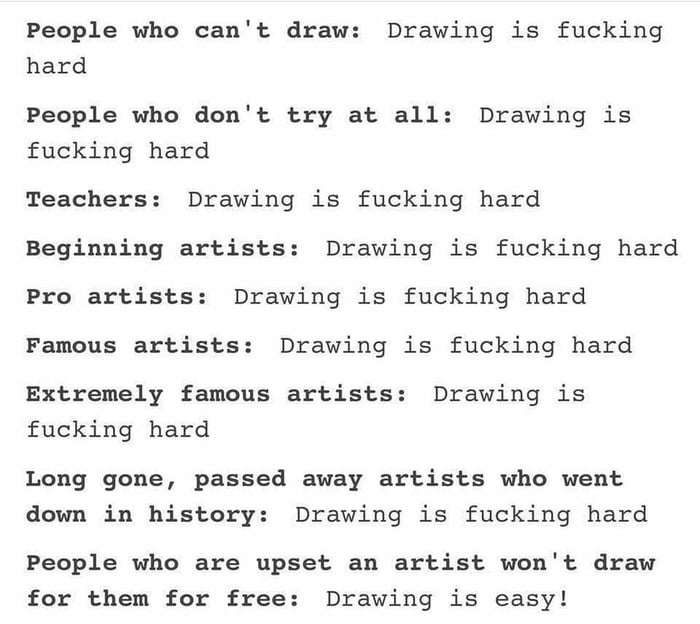I wanted to make this post because when I was first starting out, I had a SUPER hard time getting straight answers on this.
Now that we’re in a competitive “gig economy” I believe it’s more important than ever to make salaries known so that people can be paid fairly for the hard work they do. I had many bad experiences when I first broke into freelancing, and was taken advantage of, even abused by past employers.
As artists, we often just want to do good work and be recognized and validated for our creativity and skills! For many artists, the business side of things just doesn’t come naturally. The numbers, the negotiation, the boundary setting that’s necessary to run a successful business, can be hard to maintain when we as artists just want to focus on producing high quality work for our Clients, and meeting or exceeding their expectations!
The most important thing that we artists have to remember if we want to make a living out of our skills is that our skills have unique, inherent, high value. Because our skills are rare, and will become rarer with the advent of AI.

Here are sample rates based on my personal experience as well as numbers I’ve observed within the storyboard artist community among professional working artists.
These numbers also focus on rates for live action TV commercials, which is my bread and butter. Animation storyboards and live action episodic / television or movies (union gigs) operate a little differently, and you’d have to seek out experts in those specific fields for more info. Live action TV commercial storyboarding gigs are non-union gigs, meaning anyone can do them, but to work in movies and TV shows, you typically have to join a union, either east or west coast, to be allowed to work on these gigs (I believe that east coast union standard day rate is 600/day for TV and film, currently).
These are USA / USD rates. Most board artists live and work from NYC and LA, although since Covid hit, storyboard art has become a primarily remote job, with artists working at different time zones no matter where they are located! Although very rarely, directors or producers will request to work with an artist 1-on-1 still.
Standard Weekday Rate, shooting boards, black and white: 800-900 / day. Artists’ “day” being between 8-10 hours, rarely 12, with OT (hourly rate at time-and-a-half, meaning 1.5x the hourly rate of ones’ day rate) starting after the artists’ day rate ends.
Weekend / Holiday Rate, shooting boards, black and white: Some artists and agencies charge a higher rate for weekend/holiday work, (and it’s recommended that all artists should). My weekend rate is just a day rate at OT, so for me, it’s 1200, with OT starting after my day (8 hours).
Rates may vary based on client or project. Here’s some metrics to consider:
Polish: Some projects may require more attention than average, or the output might need to be much more cleaned up, rendered out, or detailed than other gigs, making it necessary to raise the rate. Some may give you extensive brand adherence guidelines to stick to, which would add a lot more to the work load.
Color: Clients might ask for a partial color / pops of color, or full color rendering for deliverables. Different artists have different coloring approaches, but the consensus is that usually adding color or creating full color boards takes more time and effort than black and white. This usually requires a different payment structure, either a per-picture rate, or increased hourly rate, since you’re getting closer to full blown “illustration” territory than simply creating reference sketches for productions, which is what boarding is supposed to be. Usually full color boards are meant for focus group testing, or proof of concept / client testing (meaning that your client, who is usually a production company, wants to prove something to their client – which is usually the brand itself, and needs super nice looking boards to make their case). Therefore, these kinds of boards have a different value not only for their workload, but due to their importance to the production process.
Likeness: If you’re working with celebrity talent who need to be represented accurately in the boards, then that’ll typically take more time and effort than average. Some artists might prep a project with likeness by studying the subjects’ face and features the night before a gig, just to try and get that likeness as accurate as possible during the gig.
Overnights / extreme OT: In the extreme case that a client comes in last minute and needs something urgently, rates can be all over the place. Negotiations vary widely, depending on artist capacity and availability. All-nighters are notoriously rough, whether you’re on set or at your desk sketching all night. It always takes me a few days to recover from them, personally. So what I end up doing is usually a project rate in these situations. Highly recommend maintaining boundaries on these kinds of soul-sucking gigs. Know that in these situations, the artist always has more leverage, because the client is SOL if they can’t get the project done. They need you.
Other types of live action gigs:
Music videos: Rates for music videos vary widely and tend to be extremely low paying, chaotic gigs. The only reasons to ever take these gigs is for clout or portfolio building. Often, music video producers will try and get away with not paying board artists, or they will ask for relentless amounts of revisions, all with tight turnaround’s, and empty promises of additional payment. I advise against doing these gigs unless you have an agent or some other way of fully vetting the producers to make sure you get paid.
Indie films: Rates vary and depend on the filmmaker, how much they value boards and how they like to work. I did boards for a bunch of NYU Tische school short and feature films in order to get my portfolio going when I first decided to take boarding seriously and try and get an agent. These gigs can be rewarding, because you get to work with people who are usually creating projects straight from the heart, that are being made for the sake of art, or some other ethereal meaning that isn’t just about selling a product or brand. So it can be satisfying to work on these kinds of things. Several films I chose to work on screened at Sundance, Tribeca, and other well known festivals around the world, getting Oscar buzz and winning indie awards. I recommend doing gigs like this for portfolio building or to expand your drawing style or approach to boarding. Don’t go into indie films like they’re a professional commercial gig, cause they just aren’t. In my experience, it was often the filmmakers’ first time working with a board artist, so I had to guide them through the process a little, and help them to understand that storyboards aren’t meant to be masterpieces, they are simply tools for production. It should be a fun experience to work on passion projects, so don’t let filmmakers treat you with disrespect just because they don’t fully understand the role of a board artist or are young or don’t have much money.
I hope this informal guide was helpful!
If you have any questions about storyboard artist rates or approaches to working with clients, feel free to message me on instagram: https://www.instagram.com/storyboardartistnyc/

